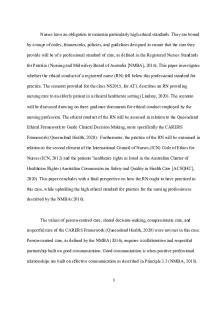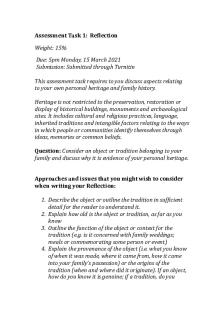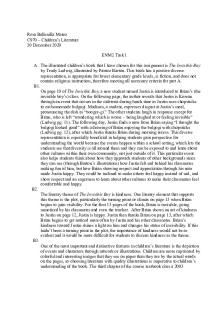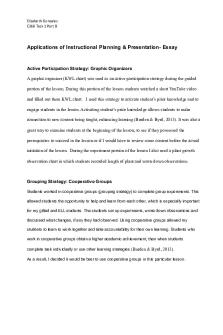Assessment TASK 1 – Scenario PDF

| Title | Assessment TASK 1 – Scenario |
|---|---|
| Author | Lulu Luo |
| Course | Diploma of Early Childhood Education and Care |
| Institution | Southern Cross Education Institute |
| Pages | 5 |
| File Size | 108.3 KB |
| File Type | |
| Total Downloads | 93 |
| Total Views | 185 |
Summary
HLTWHS003 Maintain work health and safety...
Description
ASSESSMENT TASK 1 – SCENARIO Scenario A WHS audit of Guardian Early Learning Centre has been conducted and the auditor has identified the following hazards: ● Blocked fire exit by two trolleys ● Worn rubber matting near the sink in the kitchen ● Cot in babies room is broken – the side does not lower ● Food trolley – one wheel does not rotate ● Nappies in toddlers room stored on the top shelf of cupboard located behind the change tables ● Educators sitting on children’s chairs ● Some children playing outside with no sun protection ● Smoke alarms in three rooms are not working ● Evacuation plans not displayed ● Infection control practices not consistently performed by staff e.g. no gloves when changing nappies, not washing hands after wiping a child’s nose. This audit is presented in the form of a report to the Director. The Director has discussed the report with you and asks that a risk assessment be completed and actioned. Part One 1. Complete the Risk Assessment Tool (Appendix A) for each of the hazards listed by the auditor to determine the risk control/s required to manage these hazards. 2. Identify the level of risk and prioritise the implementation of controls. 3. Consider the consequences and likelihood for each of the identified hazards to determine a risk rating. 4. After the identification of risk control/s reassess the risk to determine the residual risk level. Appendix A: Risk Assessment Tool Hazard Type/ Description Blocked fire
Risk Assessment Likelihood 3
Consequence 5
Risk Rating 15
exit
Hierarchy of
Risk Controls to be
Controls
Implemented
Director/ow
Avoid the risk
ner
by removing the hazard
Residual Risk Assessment Likelihood
Consequence
Risk Rating
4
3
12
1
2
2
Replace a new 1
1
1
completely. Slip risk
4
5
20
Supervisor
Replace that gloves with another
Broken cot
5
5
25
Manager
baby cot Food
trolley
one does
wheel not
4
5
20
Manager/st
Change
the
1
2
2
aff
wheel or a new food trolley
Room leader/man
Move the 1 nappies next to
1
1
ager
changing table
1
1
1
2
2
4
them 2
2
4
2
2
4
2
2
5
rotate
Nappies in 4 toddlers room stored on the top shelf of cupboard located behind the change tables
4
Educators
4
sitting
4
16
so that it is easily accessed
16
Manager
on
appropriate
children chairs
Some children playing outside with no sun protection
5
Smoke
5
5
25
chair educators
to
Manager/ro
Putting
on
om leader
sunscreen and hats should be mandatory
5
25
alarms in three rooms are
Manageme
Replace
nt/director
immediately with new ones
not
and
working
check
battery every 6 months
Evacuation plans
Provider
5
5
25
Manager
not
Display evacuations
displayed
plan and make sure it is visible to everyone
Infection control practices not
5
5
25
Manager/ro
Follow
nappy
om leader
changing and safety policy
consistently performed by
and remind educators
staff
about regular meetings
the
Part Two Identify a way that you could involve other staff in a consultative process about the report. Your objective is to ensure they promptly report maintenance issues, hazards and incidents and contribute to the risk assessment process. ● Include the responsibilities that you would expect the PCBU to take on as part of this activity. ● Write down what you would do, how you would do it and provide any materials or resources you would use. ● Include a brief explanation of what you would tell staff so they could see the benefits of consultation, cooperation and communication in relation to WHS at the Centre. Writing a report Write about the hazard in the communication book or on a hazard identification form. The report needs to be factual and easy to understand. Accordingly, this duty requires PCBUs to provide and maintain: a safe work environment. safe plant and structures. Speak to your HSR, nominee or committee chairperson or your supervisor or manager to ask their advice about what you should do. Putting alert tags on faulty equipment——Attach alert tags to let everyone know there is a problem with the equipment and it is not to be used. Notifying all staff——Tell the staff replacing your shift about any identified hazards. Telephoning your supervisor——Support workers may need to report the hazard or risk as soon as possible if it is serious; for example, if the front steps of an older person’s house have collapsed. WHS committees Set up a health and safety committee (HSC). A committee is a group of people who meet to talk, share information and make decisions about acertain topic. A health and safety committee will be responsible for thinking about WHS issues and how they can be solved. The committee might include: support workers maintenance staff other health professionals supervisors or managers. It is a good idea for a committee to have people from all different parts of center. This way, all the different parts can share ideas. For example, if you did not include maintenance staff, you might miss out on important ideas about how to keep equipment operating safely. Everyone on the WHS committee is responsible for thinking of ways to make the workplace as safe as possible. They will then share their ideas with the managers or your employer.
Part Three You are required to base this part of the scenario on the information provided in relation to worker’s safety at their workplace from your State’s OHS/WHS legislation, codes of practice and industry standards. Write a brief report (250 words) outlining the main aspects of the Regulations related to workers’ rights and responsibilities. Use the following questions as a guide to what to include in your report. 1. How does a worker report an injury? 2. How does a worker make a claim if injured at work? 3. What five (5) things does an employer need to do to ensure a safe working environment? 4. What are the requirements of the workplace for record-keeping and reporting? 5. What is the role of Health and Safety Representatives (HSR) in the workplace? The Work Health and Safety Act 2011 (Cth) outlines the responsibilities of the employer and the rights and responsibilities of the employee in keeping workplaces safe.Here is a summary of employees, employers and others’ responsibilities. Employee responsibilities These responsibilities are for all employees. The main things you must remember after training are to: work safely – you must follow all training, processes and procedures not put anyone else in danger and do everything you can to ensure a person’s safety, in line with your duty of care requirements
report any hazards or incidents including near misses
follow the instructions you are given use equipment, including protective equipment, properly – in the way you have
been trained and following the manufacturer’s instructions cooperate with your supervisor and employer
understand your rights and responsibilities are equally important.
It is just as important for you to follow the training you are given as it is for you to receive that training from your employer. It is also important for you to share information about any hazards or potential hazards. You must follow your workplace policies and procedures and report any hazards or incidents to the right person. This will usually be the HSR and your supervisor. Workers have a duty of care (a legal responsibility) to keep themselves, people they support and others safe, therefore, they need a basic understanding of the risks associated with various hazards. As conditions in a workplace may change, information about WHS policies and procedures should be provided regularly to work teams. Health and safety representative Health and safety representatives (HSRs) are a key link between employees and employers. They tell employers about employees’ safety and health concerns. They also help employers to make sure workplace safety processes and procedures work. To be an HSR the person must:
be employed at the workplace
be elected by members of that work group once elected, undertake training in work health and safety, approved by the
regulator (or have previously undertaken the training) Health and safety representatives:
inspect workplace areas immediately investigate accidents or risk of serious injury or harm
must keep up with information provided by the employer on hazards in the workplace, and liaise with government and other bodies
report hazards in the workplace
refer safety and health matters they think appropriate to the safety and health committee (if the workplace has one)
liaise with employees about safety and health must be informed by the employer about dangerous situations or accidents, or when
an inspector visits the workplace must be notified of any changes in the workplace that may affect employees’ safety and health can attend any safety and health discussion between an employer and an employee if the employee asks them to be there
can expect space and time to help them carry out their duties; for example, they will
need storage space to keep records and information, and time off work on normal pay to attend to the safety and health functions can expect to be trained according to the regulations – they can get paid leave to attend accredited introductory training on WHS. Report risk If a hazard or emergency situation is reported early,sometimes the impact can be reduced. For example,if you smell smoke and report it immediately, your quick action might mean a fire is found and put out while it is still small, and not much damage has been done.Reports may be made face-to-face, over the phone, using memos, or through a report form. An injured worker can make a claim by downloading a ReturnToWorkSA Claim Form and providing the information to their manager or supervisor, together with a Work Capacity Certificate supporting the claim completed by the worker's treating doctor....
Similar Free PDFs

Assessment TASK 1 – Scenario
- 5 Pages

BSBPMG522 Assessment Task 1
- 9 Pages

Assessment Task 1
- 2 Pages

Reflection Assessment Task 1
- 4 Pages

NS2015 Assessment Task 1
- 7 Pages

Assessment Task
- 3 Pages

Bsbcrt 412 - Assessment Task 1
- 5 Pages

Bsbcmm 511 - Assessment Task 1
- 14 Pages

Assessment Task 3
- 1 Pages

Remedies - Assessment Task
- 5 Pages
Popular Institutions
- Tinajero National High School - Annex
- Politeknik Caltex Riau
- Yokohama City University
- SGT University
- University of Al-Qadisiyah
- Divine Word College of Vigan
- Techniek College Rotterdam
- Universidade de Santiago
- Universiti Teknologi MARA Cawangan Johor Kampus Pasir Gudang
- Poltekkes Kemenkes Yogyakarta
- Baguio City National High School
- Colegio san marcos
- preparatoria uno
- Centro de Bachillerato Tecnológico Industrial y de Servicios No. 107
- Dalian Maritime University
- Quang Trung Secondary School
- Colegio Tecnológico en Informática
- Corporación Regional de Educación Superior
- Grupo CEDVA
- Dar Al Uloom University
- Centro de Estudios Preuniversitarios de la Universidad Nacional de Ingeniería
- 上智大学
- Aakash International School, Nuna Majara
- San Felipe Neri Catholic School
- Kang Chiao International School - New Taipei City
- Misamis Occidental National High School
- Institución Educativa Escuela Normal Juan Ladrilleros
- Kolehiyo ng Pantukan
- Batanes State College
- Instituto Continental
- Sekolah Menengah Kejuruan Kesehatan Kaltara (Tarakan)
- Colegio de La Inmaculada Concepcion - Cebu





